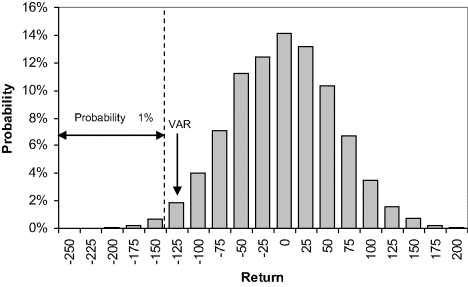2.3 Value-at-Risk
2.3.1 Definition
Quantitative approaches to financial risk management have been widely adopted in recent times, in particular with the popularity of the value-at-risk (VAR) concept. Initially designed as a metric for market risk, VAR has subsequently been used across many financial areas as a means for efficiently summarising risk via a single quantity. A VAR number has a simple and intuitive explanation as the worst loss over a target horizon to a certain specified confidence level. The VAR at the α% confidence level gives a value that will be exceeded with no more than a ![]() probability. An example of the computation of VAR is shown in Figure 2.1. The VAR at the 99% confidence level is 125 (by convention the “worst loss” is expressed as a positive number) since the probability that this will be exceeded is no more than 1% (it is actually 0.92% due to the discrete1 nature of the distribution). To find the VAR, one looks for the minimum value that will be exceeded with no more than the specified probability.
probability. An example of the computation of VAR is shown in Figure 2.1. The VAR at the 99% confidence level is 125 (by convention the “worst loss” is expressed as a positive number) since the probability that this will be exceeded is no more than 1% (it is actually 0.92% due to the discrete1 nature of the distribution). To find the VAR, one looks for the minimum value that will be exceeded with no more than the specified probability.
Figure 2.1 Illustration of the value-at-risk (VAR) concept at the 99% confidence level. The VAR is 125, since the chance of a loss (negative return) greater than this amount is no more than 1%.

VAR may be used to set regulatory capital requirements. For example, ...
Get Counterparty Credit Risk and Credit Value Adjustment: A Continuing Challenge for Global Financial Markets, 2nd Edition now with the O’Reilly learning platform.
O’Reilly members experience books, live events, courses curated by job role, and more from O’Reilly and nearly 200 top publishers.

